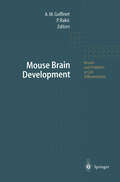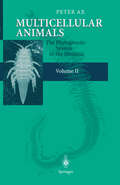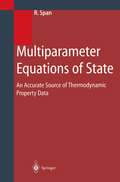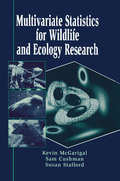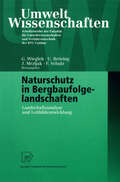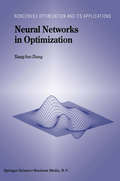- Table View
- List View
Mountain Geoecology and Sustainable Development of the Tibetan Plateau (GeoJournal Library #57)
by Du Zheng Qingsong Zhang Shaohong WuIntense uplift of the Tibetan Plateau in Late Cenozoic Era is one of the most important events in geological history of the Earth. The plateau offers an ideal region for studying of lithospheric formation and evolution, probing into the mechanism of crustal movement, and understanding of changes in environments and geo-ecosystems in Asia. Intense uplift ofthe plateau resulted in drastic changes of natural environment and apparent regional differentiation on the plateau proper and neighboring regions. The plateau therefore becomes a sensitive area of climate change in Asian monsoon region, which is closely related to the global change. As a special physical unit, its ecosystems occupy a prominent position in the world. Due to its extremely high elevation and great extent, natural types and characteristics of physical landscapes on the plateau are quite different from those in lowlands at comparable latitudes, and environments are also different from those in high latitudinal zones. Consequently, the Tibetan Plateau has been classified as one of three giant physical regions in China and considered as a unique unit on Earth. Scientific surveys and expeditions to the Tibetan Plateau on large scale began from 1950's. Amongst them, a number of comprehensive scientific expeditions to the Xizang (Tibet) Autonomous Region, Hengduan Mts. areas, Karakorum and Kunlun Mts. regions, as well as the Hoh Xii Mts. areas, have been successively carried out by the Integrated Scientific Expedition to Tibetan Plateau, sponsored by Chinese Academy of Sciences since 1973.
Mouse Brain Development (Results and Problems in Cell Differentiation #30)
by Andre M. Goffinet Pasko RakicOur understanding of the molecular mechanisms involved in mammalian brain development remains limited. However, the last few years have wit nessed a quantum leap in our knowledge, due to technological improve ments, particularly in molecular genetics. Despite this progress, the available body of data remains mostly phenomenological and reveals very little about the grammar that organizes the molecular dictionary to articulate a pheno type. Nevertheless, the recent progress in genetics will allow us to contem plate, for the first time, the integration of observation into a coherent view of brain development. Clearly, this may be a major challenge for the next century, and arguably is the most important task of contemporary develop mental biology. The purpose of the present book is to provide an overview that syn thesizes up-to-date information on selected aspects of mouse brain devel opment. Given the format, it was not possible to cover all aspects of brain development, and many important subjects are missing. The selected themes are, to a certain extent, subjective and reflect the interests of the contributing authors. Examples of major themes that are not covered are peripheral nervous system development, including myelination, the development of the hippocampus and several other CNS structures, as well as the developmental function of some important morphoregulatory molecules.
MRCP: Early Diagnosis of Pancreatobiliary Diseases
by Jinkan Sai Joe AriyamaMagnetic resonance cholangiopancreatography (MRCP) is a newly developed noninvasive diagnostic technique for sectional and projectional imaging of the pancreatobiliary tree. Requiring no contrast materials, MRCP provides high-quality 2-D and 3-D images that facilitate early diagnosis and treatment of pancreatobiliary diseases. The authors draw upon their experience of more than 3000 MRCP studies as they illustrate the usefulness of this important new diagnostic modality. This volume is a valuable resource with state-of-the-art information for practitioners, researchers, and others in the fields of gastroenterology, radiology, and surgery.
MRI Atlas of the Human Cerebellum
by Jeremy D. Schmahmann Julien Doyon Michael Petrides Alan C. Evans Arthur W. TogaThe MRI Atlas of the Human Cerebellum constitutes the most complete, detailed work on the human cerebellum to date. This definitive work provides images in the three cardinal planes (sagittal, transverse, and coronal) at closely spaced intervals of 2 millimeters. The images are derived from MRI scans of one individual and from postmortem sections of another. It is the only such atlas set within the universally accepted framework of the Talairach stereotaxic system, derived from standard landmarks in the brain. The book includes a new nomenclature system (labeling system) which is easier to use, aids in understanding the organization of the cerebellum, and is consistent with earlier work on the anatomy of the cerebellum in animals and the development of the human cerebellum in infants.Recent studies have shown that the cerebellum is involved in much more than motor coordination alone: also in higher functions including memory, language, emotion, and attention, as well as sensory discrimination. This atlas facilitates this new era of study of the cerebellum, allowing investigators to identify cerebellar structures with precision. Everyone concerned with the anatomy, function, or dysfunction of the cerebellum should have a copy.Key Features* Provides the most comprehensive, detailed, and authoritative atlas of the human cerebellum* Contains 110 MRI images and 110 corresponding cryosection images* Includes a CD with all of the images and text from the book, supported by both PC and Macintosh computer platforms* Developed within the universally accepted framework of the Talairach stereotaxic system* Contains detailed myelin- and Nissl-stained histology of major nuclei* Presents a new, easy-to-use nomenclature system* Allows investigators to identify structures with precision and to address detailed structure-function correlations
Multi-Valued and Universal Binary Neurons: Theory, Learning and Applications
by Igor Aizenberg Naum N. Aizenberg Joos P.L. VandewalleMulti-Valued and Universal Binary Neurons deals with two new types of neurons: multi-valued neurons and universal binary neurons. These neurons are based on complex number arithmetic and are hence much more powerful than the typical neurons used in artificial neural networks. Therefore, networks with such neurons exhibit a broad functionality. They can not only realise threshold input/output maps but can also implement any arbitrary Boolean function. Two learning methods are presented whereby these networks can be trained easily. The broad applicability of these networks is proven by several case studies in different fields of application: image processing, edge detection, image enhancement, super resolution, pattern recognition, face recognition, and prediction. The book is hence partitioned into three almost equally sized parts: a mathematical study of the unique features of these new neurons, learning of networks of such neurons, and application of such neural networks. Most of this work was developed by the first two authors over a period of more than 10 years and was only available in the Russian literature. With this book we present the first comprehensive treatment of this important class of neural networks in the open Western literature. Multi-Valued and Universal Binary Neurons is intended for anyone with a scholarly interest in neural network theory, applications and learning. It will also be of interest to researchers and practitioners in the fields of image processing, pattern recognition, control and robotics.
Multicellular Animals: Volume II: The Phylogenetic System of the Metazoa
by Peter AxThe system of multicellular animals presented here is an alternative to the traditional classification system. In a new approach to the phylogenetic order, this book strives for an objective systematization of the metazoa, seeking a new path in the field of academic research and teaching.
Multiparameter Equations of State: An Accurate Source of Thermodynamic Property Data
by Roland SpanAs a basis for printed property charts and tables, empirical multiparameter equa tions of state have been the most important source of accurate thermodynamic property data for more than 30 years now. However, due to increasing demands on the accuracy of thermodynamic property data in computerised calculations as well as the availability of appropriate software tools, and the ever increasing computer power, such formulations are nowadays becoming a valuable tool for everyday work. This development has substantially increased the number of scientists, engi neers, and students who are working with empirical multiparameter equations of state, and it continues to do so. Nevertheless, common knowledge on this kind of thermodynamic property models and on the ongoing progress in this scientific discipline is still very limited. Multiparameter equations of state do not belong to the topics which are taught intensively in thermodynamic courses in engineering and natural sciences and the books and articles where they are published mainly deal with the thermodynamic properties of certain substances rather than with the theoretical background of the used equations of state. In contrast to this, my concern mainly was to give a survey of the theoretical background of multiparameter equations of state both with regard to their application and their development.
Multiphoton and Light Driven Multielectron Processes in Organics: Proceedings of the NATO Advanced Research Workshop on Multiphoton and Light Driven Multielectron Processes in Organics: New Phenomena, Materials and Applications Menton, France 26–31 August 1999 (NATO Science Partnership Subseries: 3 #79)
by F. Kajzar Vladimir M. AgranovichProceedings of the NATO Advanced Research Workshop, Menton, France, 26-31 August, 1999
Multiphoton Processes in Atoms: Second Enlarged and Updated Edition With 122 Figures and 11 Tables (Springer Series on Atomic, Optical, and Plasma Physics #13)
by N.B. Delone V.P. KrainovThis book presents a detailed, modern description of the ionization of atoms by strong laser radiation. The authors present descriptions of processes occurring in atoms under the action of strong electromagnetic radiation, in particular, the shift, broadening, and mixing of atomic states. The topics include tunneling ionization, above-threshold ionization, ionization of multiply charged ions, resonance-enhanced ionization, super-intense radiation fields, and properties of Rydberg states strongly perturbed by laser radiation.
Multiple Scattering in Solids (Graduate Texts in Contemporary Physics)
by Antonios Gonis William H. ButlerA description of general techniques for solving linear partial differential equations by dividing space into regions to which the equations are independently applied and then assembling a global solution from the partial ones. Intended for researchers and graduates involved in calculations of the electronic structure of materials, this will also be of interest to workers in quantum chemistry, electron microscopy, acoustics, optics, and other fields. The book begins with an intuitive approach to scattering theory and then turns to partial waves and a formal development of multiple scattering theory, with applications to the solid state. The authors then present a variational derivation of the formalism and an augmented version of the theory, concluding with a discussion of the relativistic formalism and a discussion of the Poisson equation. Appendices discuss Green's functions, spherical functions, Moller operators and the Lippmann-Schwinger equation, irregular solutions, and singularities in Green's functions.
Multivariate Statistics for Wildlife and Ecology Research
by Kevin McGarigal Samuel A. Cushman Susan StaffordWith its focus on the practical application of the techniques of multivariate statistics, this book shapes the powerful tools of statistics for the specific needs of ecologists and makes statistics more applicable to their course of study. It gives readers a solid conceptual understanding of the role of multivariate statistics in ecological applications and the relationships among various techniques, while avoiding detailed mathematics and the underlying theory. More importantly, the reader will gain insight into the type of research questions best handled by each technique and the important considerations in applying them. Whether used as a textbook for specialised courses or as a supplement to general statistics texts, the book emphasises those techniques that students of ecology and natural resources most need to understand and employ in their research. While targeted for upper-division and graduate students in wildlife biology, forestry, and ecology, and for professional wildlife scientists and natural resource managers, this book will also be valuable to researchers in any of the biological sciences.
Municipal Waste Management in Europe: A Comparative Study in Building Regimes (Environment & Management #10)
by OlivierGodard NicolasBucletNicolas Buclet and Olivier Godard In terms of economic scale, waste management is one of the two most important environmentally oriented sectors. 1 It stands at the cross-roads in the material organization of society, resource management, changing lifestyles and consumption patterns, and ecological issues. For many years waste management has been perceived as aresources and health issue, confined mainly to dense urban areas, and not an environmental issue. In contemporary affiuent societies, however, the scale reached by waste flows, the inheritance of accumulated deposits in soils from the waste of previous generations and increasing levels of public concern about environmental proteetion and quality of life have all conspired to impose a fresh look at what waste really implies for a modern society. We are obliged to focus our attention on such questions as how the circulation of matter is at present organized by society and can be modified and controlled if economic development is to become more environmentally sustainable. This is the period we live in. Significant changes in waste management in European countries have been introduced during the last decade or so. To some extent the transition between traditional regimes mainly based on local disposal and new regimes based on a revised organisation of flows of waste matter is still in the making, involving new attitudes, new activities, new technologies and new incentives, reducing the pressure on virgin natural resources and eliminating the huge dissipation of various pollutants into the environment.
Myasthenia Gravis: Disease Mechanism and Immunointervention
by PremkumarChristadossAutoimmune myasthenia gravis (MG) is a classical autoimmune disease, for which the target antigen, nicotinic acetylcholine receptor, has been cloned, sequenced and biochemically characterized. Antibodies to acetylcholine receptors destroy acetylcholine receptor at the neuromuscular junction, thus leading to defective neuromuscular transmission, muscle fatigue, and weakness. In the last few years, rapid advances have been made in unraveling the cellular and molecular mechanisms involved in the pathogenesis of MG, both in the animal model, experimental autoimmune MG (EAMG), and in human MG. Significant advances are being made in characterizing the cells and molecules involved in the autoimmune response to the acetylcholine receptor (AChR). These advances are leading to the development of specific methods of immunointervention in EAMG. Further understanding of the intricate involvement of the major histocompatibility complex (MHC) and non-MHC genes, T cell receptors (TCR), costimulator molecules, and specific cytokines in the afferent and efferent autoimmune response of AChR should pave the way to future antigen/clone-specific therapy of MG. This book is the outcome of the MG workshop proceedings in Mysore, India, 1998. The majority of the chapters in this book are contributed by world-renowned authors and their students. The book not only contains a timely review of specific topics, but also up-to-date findings. Immunologists and neurologists will find, in this volume, the latest in MG/EAMG cutting-edge research. Clinicians will be interested in the applications of the various immunointervention strategies into clinical trials in MG patients. Finally, students will not only be interested in reading the latest in EAMG/MG research, but will also find information to help them develop a future strategy to unravel the precise mechanism of disease. To summarize, in this book, the readers should find up-to-date information related to immunological mechanisms involved in MG pathogenesis and various modalities for possible approaches to immunointervention to treat MG.
Mycorrhizal Biology
by K. G. Mukerji B. P. Chamola Jagjit Singh`The fundamental problem the world faces today, is the rapidly increasing pressure of population on the limited resources of the land. To meet the ever increasing demands of expanding populations, agricultural production has been raised through the abundant use of inorganic fertilizers, the adoption of multicropping systems and liberal application of chemical pesticides (fungicides, bactericides, etc. ). Though the use of chemicals has increased the yield dramatically, it has also resulted in the rapid deterioration of land and water resources apart from wastage of scarce resources. This has adversely affected the biological balance and lead to the presence of toxic residues in food, soil and water in addition to imposing economic constraints on developing countries.' (From the Preface) Mycorrhizal Biology addresses the global problem of land degradation and the associated loss of soil productivity and decline in soil quality caused by exploitative farming practices and poor management in developing countries, and the far reaching socio-economic and ecological consequences of its impact on agricultural productivity and the environment. In the light of a need for sustainable development, a new system of productive agriculture, to ensure the efficient management of agricultural inputs for long term high crop productivity with minimum damage to the ecological and socio-economic environment is essential. The management of mycorrhizal fungi will form a significant part of such a system and this work investigates the key association of plant roots with mycorrhizal fungi, known to benefit plants under conditions of nutritional and water stress and pathogen challenge and analyses the developments in our understanding of the genetic loci that govern mycorrhiza formation.
Nanotechnology Research Directions: Vision for Nanotechnology in the Next Decade
by R. S. Williams P. Alivisatosenergy production, environmental management, transportation, communication, computation, and education. As the twenty-first century unfolds, nanotechnology's impact on the health, wealth, and security of the world's people is expected to be at least as significant as the combined influences in this century of antibiotics, the integrated circuit, and human-made polymers. Dr. Neal Lane, Advisor to the President for Science and Technology and former National Science Foundation (NSF) director, stated at a Congressional hearing in April 1998, "If I were asked for an area of science and engineering that will most likely produce the breakthroughs of tomorrow, I would point to nanoscale science and engineering. " Recognizing this potential, the White House Office of Science and Technology Policy (OSTP) and the Office of Management and Budget (OMB) have issued a joint memorandum to Federal agency heads that identifies nanotechnology as a research priority area for Federal investment in fiscal year 2001. This report charts "Nanotechnology Research Directions," as developed by the Interagency W orking Group on Nano Science, Engineering, and Technology (IWGN) of the National Science and Technology Council (NSTC). The report incorporates the views of leading experts from government, academia, and the private sector. It reflects the consensus reached at an IWGN-sponsored workshop held on January 27-29, 1999, and detailed in contributions submitted thereafter by members of the V. S. science and engineering community. (See Appendix A for a list of contributors.
The National Innovation System of Belgium (Contributions to Economics)
by Henri Capron Wim MeeusenThis book deals with aspects of the national innovation system of Belgium. It is the result of a study jointly undertaken by teams of the University of Antwerp (RUCA) and the Free University of Brussels (ULB) in the context of the OECD DSTI Working Group on Innovation and Technology Policy, which brought to gether specialists from most of the OECD countries in an effort to streamline and co-ordinate research on national innovation systems. The 'systemic' approach - as opposed to the traditional 'linear causal' ap proach - has, in recent years, increasingly become the framework for the study of the complex relationships between R&D, innovation, the economic performance of firms and of the economy in which they operate, technological policy, and, fi nally, the institutional framework of the national economy, including its transna tional aspects. Obviously, the systemic approach did not fall out of the blue but has its roots in different schools of economic thought. The theoretical foundations of the national innovation system approach are therefore first discussed in Chapter 1. Chapters 2 and 3 introduce the reader to some peculiarities of the Belgian economy. Chapter 2 deals with the sources of Belgian prosperity, looked at from a long-term perspective and with particular attention being given to the small-open-economy characteristics of Belgium.
Natural Terpenoids as Messengers: A multidisciplinary study of their production, biological functions and practical applications
by Paul Harrewijn A.M. van Oosten P.G. PironIn contrast to books on specific bioactive compounds, this book deals with the role of mevalonic acid metabolites (isoprenoids and their derived structures) in metabolism, development, and functions of organisms, which, though diverse, show various levels of communication. Different disciplines are brought together in a discussion of the messenger functions of terpenoids within and between organisms belonging to five biological kingdoms: bacteria, fungi, plants, insects, and vertebrates (including humans). The present volume covers evolutionary aspects of terpenoids in plant physiology, plant-insect relationships, semiochemicals, and in life sciences, with special emphasis on cancer research and treatment. The book provides proposals for multidisciplinary model systems for the study of interrelationships of organisms utilizing terpenoid messengers, and discusses novel strategies for insect control and multifactor treatments of cancer utilizing terpenoids. This book is of interest to scientists, and students at an advanced level: biologists, plant breeders, pharmacologists, specialists in medical fields, especially oncologists, physicians in general, and anyone with a basic biochemical and physiological knowledge.
Naturschutz in Bergbaufolgelandschaften: Landschaftsanalyse und Leitbildentwicklung (UmweltWissenschaften)
by Gerhard Wiegleb Udo Bröring Jadranka Mrzljak Friederike SchulzNeural Networks in Optimization (Nonconvex Optimization and Its Applications #46)
by Xiang-Sun ZhangPeople are facing more and more NP-complete or NP-hard problems of a combinatorial nature and of a continuous nature in economic, military and management practice. There are two ways in which one can enhance the efficiency of searching for the solutions of these problems. The first is to improve the speed and memory capacity of hardware. We all have witnessed the computer industry's amazing achievements with hardware and software developments over the last twenty years. On one hand many computers, bought only a few years ago, are being sent to elementary schools for children to learn the ABC's of computing. On the other hand, with economic, scientific and military developments, it seems that the increase of intricacy and the size of newly arising problems have no end. We all realize then that the second way, to design good algorithms, will definitely compensate for the hardware limitations in the case of complicated problems. It is the collective and parallel computation property of artificial neural net works that has activated the enthusiasm of researchers in the field of computer science and applied mathematics. It is hard to say that artificial neural networks are solvers of the above-mentioned dilemma, but at least they throw some new light on the difficulties we face. We not only anticipate that there will be neural computers with intelligence but we also believe that the research results of artificial neural networks might lead to new algorithms on von Neumann's computers.
Neuronal Nicotinic Receptors (Handbook of Experimental Pharmacology #144)
by F. Clementi D. Fornasari C. GottiNeuronal nicotinic receptors are key molecules for signal transduction in a number of neuronal pathways. They are widely distributed in the brain and are known to be involved in cognitive tasks, including learning and memory, in smoking addiction and in several brain diseases, such as Alzheimer's and Parkinson's dementias, schizophrenia, and epilepsy. This book provides a comprehensive review of the field, starting with a historical perspective and dealing with the molecular structure of these receptors, their biophysical and pharmacological properties, their distribution in central and peripheral nervous systems, and their major involvement in brain functions. Particular emphasis is paid to drugs (both new and old) that are useful in the diagnosis and treatment of diseases involving neuronal nicotinic receptors. Finally, the relevance of these receptors in smoking addiction is carefully evaluated, together with future trends and the latest results.
Neuropsychological Evaluation of the Older Adult: A Clinician's Guidebook
by Joanne GreenOne of the largest patient populations seen by neuropsychologists are older adults suffering from problems associated with aging. Further, the proportion of the population aged 65 and above is rising rapidly. This book provides a guide to neuropsychological clinicians increasingly called upon to assess this population. The book details in a step-by-step fashion the phases and considerations in performing a neuropsychological assessment of an older patient. It covers procedural details including review of patient's medical records, clinical interview, formal testing, interpretation of test scores, addressing referral questions, and preparing an evaluation report.Outlines a clear, logical approach to neuropsychological evaluationProvides specific clinical practice guidelines for each phase of the evaluationIntegrates clinical practice with up-to-date research findingsRecommends specific tests for evaluating older adultsDetails how to interpret test findings and identify the patient's neuropsychological profileIllustrates important points with examples and case materials, many neuropathologically-confirmedIncludes forms useful in clinical practice
Neuropsychological Sequelae of Subarachnoid Hemorrhage and its Treatment
by B.O. HütterThe first monograph dealing exclusively with the neuropsychological and psychosocial sequelae of subarachnoid hemorrhage (SAH) and its treatment. It provides an overview of basic treatment modalities and functional outcome after SAH with special emphasis on aneurysm surgery. In the methods section, neuropsychological, neuropsychiatric and capacity of daily life assessment issues in patients after SAH are reviewed, and the neuroanatomical basis of the neurobehavioral abnormalities after SAH is critically discussed. Furthermore, the frequently overseen aspects of psychological adjustment including quality of life after SAH, the hemorrhage as a psychological trauma, and rehabilitational issues are met in this book.
New Developments in High Temperature Superconductivity: Proceedings of the 2nd Polish-US Conference Held at Wrocław and Karpacz, Poland, 17–21 August 1998 (Lecture Notes in Physics #545)
by J. Klamut B. W. Veal B. M. Dabrowski P. W. Klamut M. KazimierskiThis volume contains the proceedings of The Second Polish-US Conf- ence on High Temperature Superconductivity which was held August 18-21, 1998 in Karpacz, Poland. The conference followed The First Polish-US C- ference on High Temperature Superconductivity organized in 1995, proce- ings of which were published by Springer-Verlag in 1996 (Recent Devel- ments in High Temperature Superconductivity, Lecture Notes in Physics 475). High Temperature Superconductivity (HTSC) in complex copper oxides has become a household name after twelve years of intense research following its discovery in 1986 by J. G. Bednorz and K. A. Miiller. Because of the rapid growth of the HTSC field, there is a need for periodic summary and conden- tion both for scientists working in the field and, especially, for young resear- ers entering the field of oxide materials. Following the First Conference, it was recognized that an extended format of lectures perfectly satisfied that need, providing adequate time for experts from the international community to fully introduce and develop complex ideas. Thus, the format of the Second Conference brought together by cooperating scientists from the Institute of Low Temperature and Structure Research of the Polish Academy of Science at Wroctaw, Northern Illinois University, and Argonne National Laboratory remained mostly unchanged. Again, we were delighted to receive enthusiastic responses from distinguished US and Polish scientists who were invited to p- ticipate.

